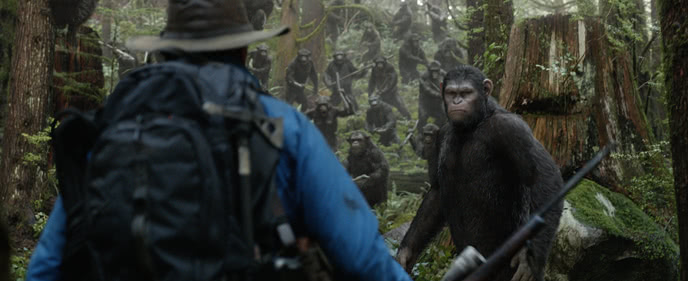Set a decade after the 2011 reboot of thePlanet Of The Apesfranchise,Dawn Of The Planet Of The Apesis, essentially, a story of survival. The simian virus has all but decimated the human population. A small group of survivors, led by Dreyfus (Gary Oldman), reaches a tenuous – and ultimately disastrous – truce with the genetically modified apes, led by Caesar (Andy Serkis). The BRAG sat down with visual effects supervisor Erik Winquist to discuss the making of this spectacular sequel.
Having worked at Weta Digital on effects-driven films such as Avatar, King Kong and the Lord Of The Rings trilogy, Winquist has seen incredible advances in technology. “Now, with digital technology, if you can dream it you can do it – that’s true if you have infinite budget and infinite time,” he says. What is especially remarkable about Dawn Of The Planet Of The Apes is the integration of physical footage with computer-generated (CG) animation. Much of the motion capture work was shot outdoors in the forests of Vancouver, and this ambitious decision understandably posed challenges – yet ultimately permitted the actors, and thus the audience, to become wholly immersed in the narrative.
Winquist has a unique insight into the complex processes that made possible one of the film’s most spectacular visual achievements: the creation of the photorealistic apes. “Matt [Reeve, director]’s real desire here was not to cast, not to find somebody who can act like an ape, but was to find a really good actor who could just deliver a really convincing dramatic performance. Once he found his performers that we were happy with, we talked to Terry Notary – who is our motion coach on the show, and also played the character of Rocket – went through and did ‘ape camp’, basically, with all of the actors and sort of taught them to walk and move and think like an ape.”
Through motion capture technology, these actors were virtually transformed into animals – Winquist describes them as essentially “driving a virtual puppet”.
“At Weta, we bring our motion capture equipment to the set; we put our ape performers in their motion capture grey onesies with the active LED markers on them,” he explains. “They’re also wearing a face cam … in a similar sort of vein, we can take the movement of what their face did from frame to frame and transpose that, translate it, put it onto the geometry of the character they’re playing.”
These virtual characters were fashioned by a team of close to 1,000 visual effects artists at Weta. Winquist mentions “our modelling department, who’s basically our experts in grooming apes at this point, growing digital hair; we’ve got our shader department, who makes sure that that hair actually looks like real hair when it’s rendered; [the] textures department is making sure that the skin has all the characteristics that you see.”
Aside from the CG characters, visual effects artists envisaged a post-apocalyptic cityscape engulfed by nature, with scenes of urban decay in what is recognisably San Francisco.
“James Chinlund, the production designer, gave us loads of fantastic material to work with as a visual guide as to what this world now looks like,” says Winquist. “He and his art directors obviously spent loads of time poring over lots of references of abandoned cities; looked at, for example, the Ukraine after Chernobyl, and what that looks like present day – what happens when mankind disappears from a city, and how quickly nature actually does take over.”
Dawn Of The Planet Of The Apesis in cinemas Wednesday July 9.


































